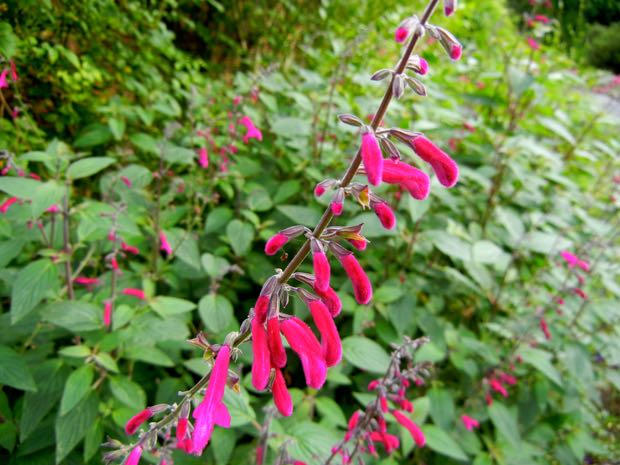Salvia curviflora – Pink Tehuacan Sage
Overview: Salvia curviflora, also known as Pink Tehuacan Sage or Tubular Bells, is a woody-based perennial native to Mexico. Belonging to the Lamiaceae family, this upright and bushy Salvia species blooms with small tubular flowers in deep magenta on tall spikes, featuring a distinct curved lower lip. With its long blooming period in spring and summer, Salvia curviflora adds a touch of vibrant color to any garden or landscape.
Plant Size and Characteristics:
Salvia curviflora grows to a height of approximately 4 feet (1.2 meters). It is well-suited for bedding and thrives in both sunlit and semi-shady areas. The stunning magenta flowers make it an excellent choice for brightening up corners of the garden. Additionally, it can be grown successfully in containers. Aside from its ornamental value, Salvia curviflora also possesses scented leaves, adding another sensory dimension to its appeal.
Cultivation Tips for Salvia curviflora:
Sunlight and Location: Salvia curviflora thrives in the sun, but it is also tolerant of dry and shady locations. Choose a sheltered spot that receives adequate sunlight throughout the day. It is a relatively easy-to-grow plant, and it is not commonly plagued by pests or diseases.
Soil and Watering: Plant Salvia curviflora in average, well-drained soil in borders or containers. Avoid planting it in excessively rich soil or water-logged conditions, as this can negatively impact its growth. Water the plant moderately, allowing the soil to dry slightly between waterings. Once established, it exhibits good tolerance to drought conditions.
Wildlife Attraction: Salvia curviflora is known to attract bees, hummingbirds, and butterflies, making it a beneficial addition to pollinator-friendly gardens. The vibrant flowers act as a magnet for these delightful creatures, enhancing the overall biodiversity of the area.
Maintenance and Propagation:
- Deadheading: To encourage continuous blooming, regularly deadhead the spent flowers of Salvia curviflora. Simply remove the faded flower spikes by cutting them back to the base of the plant.
- Aromatic Foliage: Like other members of the Sage family, Salvia curviflora possesses aromatic foliage that adds an extra dimension to its sensory appeal. Brushing against the leaves releases a delightful fragrance into the surrounding air.
- Propagation: Salvia curviflora can be propagated through both cuttings and division. Take stem cuttings at any time of the year or divide established plants to create new specimens. Both methods can help expand your Salvia curviflora collection or share this beautiful plant with others.
- Hardiness and Safety: Salvia curviflora is deer-resistant and can tolerate temperatures down to -4°C. It is safe for humans and animals, as it does not pose any significant toxicity concerns.
With its striking magenta flowers, delightful fragrance, and easy cultivation, Salvia curviflora is a captivating addition to any garden. Whether used as a focal point in borders, containers, or mixed plantings, this Pink Tehuacan Sage will bring joy and beauty to your outdoor space.





